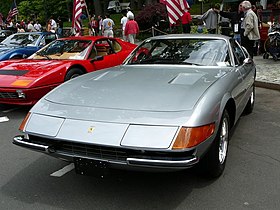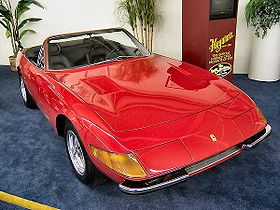Ferrari Daytona
| Ferrari 365 "Daytona" GTB/4, GTS/4, GTC/4, GT4 2+2 | |
|---|---|
| Manufacturer: | Ferrari |
| Class: | front-engined sports car |
| Production: | 1968 — 1976 1406 produced |
| Engines: | 4.4 L Colombo V12 |
| 365 GTB/4 | |

| |
| Production: | 1968 — 1973 |
| Predecessor: | 330 GTC 275 GTB/4 |
| Body styles: | Berlinetta |
| 365 GTS/4 | |

| |
| Production: | 1971 — 1973 |
| Predecessor: | 275 GTS 330 GTS 365 GTS |
| Body styles: | Spider |
| 365 GTC/4 | |

| |
| Production: | 1971 — 1972 |
| Predecessor: | 365 GTC |
| Body styles: | 2+2 Coupe |
| 365 GT4 2+2 | |
| Production: | 1972 — 1973 |
| Predecessor: | 365 GT 2+2 |
| Successor: | 400 Automatic |
| Body styles: | 2+2 Coupe |
The Ferrari Daytona (correctly named the 365 GTB/4) was a Gran Turismo automobile produced from 1968 to 1973. It replaced the 275GTB/4 but, although it was also a Pininfarina design, the Daytona was radically different. Its sharp-edged styling and covered headlights resembled a Lamborghini more than a traditional Pininfarina Ferrari. The Daytona name was chosen to commemorate Ferrari's success in the 24 Hours of Daytona race.
Unlike Lamborghini's new Miura, the Daytona was a traditional front-engined, rear-drive car. Customers were disappointed that Ferrari stuck with this layout, and the Daytona was replaced by the mid-engined 512 Berlinetta Boxer.
The engine was a 4.4 L (4390 cc) DOHC V12. It produced 352 bhp DIN (259 kW) and could reach 280 km/h (174 mph). 0-60 mph acceleration was just 5.4 seconds.
The 5-speed manual transmission was mounted in the rear for optimal weight distribution, and a 4-wheel independent suspension featured wishbones and coil springs.
The Daytona gained new notoriety in the 1980s as Detective Sonny Crockett's car in the first years of the TV show Miami Vice. Ironically, the actual car used for filming was a modified Chevrolet Corvette. Ferrari, reportedly miffed that a fake was getting so much attention, supplied two new Testarossas for use in the show. Still, another fake (this time a modified DeTomaso Pantera) was used for stunts.
In 2004, the Daytona was voted top sports car of the 1970s by Sports Car International magazine. Similarly, Motor Trend Classic named the 365 GTB/4 and GTS/4 as number two in their list of the ten "Greatest Ferraris of all time".
| Ferrari 365 GTB4 Daytona Spider |
|---|
Model variations
365 GTS/4
The generally accepted total number from the Ferrari club historians is 1,284 over the life of the model. That includes 122 Spyders, of which 7 were right hand drive, that were converted from the Coupe to the Spyder for the factory by Scaglietti - the Daytona body builder, and 15 competition cars in three series with modified lightweight bodies in various degrees of engine tune. I am in posession of a telex from the Ferrari factory listing the individual Spyder chassis numbers. A good reference book is titled "The Ferrari 365GTB/4 DAYTONA" by Pat Braden and Gerald Roush, and published by Osprey in 1982.
Historically, and especially since the mid-80s and early 90s, there has mostly been a considerable market price difference between a real Berlinetta and a real Spyder. In hope for higher value and prospective sale revenue or even due to the fact that not too many factory spyders were ever built, some Berlinettas were turned into convertibles. They are usually distinguishable from a factory-made GTS by a more slanted windshield.
365 GTC/4
Although not generally recognized as a true "Daytona", the 1971 365 GTC/4 used the same chassis. Its coupe bodywork by Pininfarina enclosed four seats, making it a successor to the 2+2 330 GTC and 365 GTC. 500 GTC/4s were produced in two years.
The GTC/4 rode on the same wheelbase and suspension as the Daytona, though the engine was down in power a bit to 340 bhp DIN (250 kW), as well as it having an engine-mounted gearbox instead of the axle-mounted (transaxle) gearbox in the Daytona.
This car was seen in Herbie Goes to Monte Carlo. It was painted a very dark shade of green with a black numeral 70 against an off-white square background.
365 GT4 2+2
In 1972, just a year after the debut of the GTC/4, a new 2+2 debuted in Paris. The 365 GT4 2+2 featured all-new bodywork with just a resemblance to the Daytona. Its angular look would go on to be used by many 1980s Ferraris, especially the Mondial. The wheelbase was 200 mm longer at 2700 mm, but most of the mechanicals, including the engine, were carried over. The GT4 was replaced in 1976 by the new 400 Automatic.
1973 Ferrari 365 GTB4 Daytona
- 1973 Ferrari 365 GTB4 Daytona 1.jpg
- 1973 Ferrari 365 GTB4 Daytona 2.jpg
- 1973 Ferrari 365 GTB4 Daytona 3.jpg
- 1973 Ferrari 365 GTB4 Daytona 4.jpg
- 1973 Ferrari 365 GTB4 Daytona 5.jpg
- 1973 Ferrari 365 GTB4 Daytona 6.jpg
- 1973 Ferrari 365 GTB4 Daytona 7.jpg
- 1973 Ferrari 365 GTB4 Daytona 8.jpg
- 1973 Ferrari 365 GTB4 Daytona 9.jpg
- 1973 Ferrari 365 GTB4 Daytona 10.jpg
- 1973 Ferrari 365 GTB4 Daytona 11.jpg
- 1973 Ferrari 365 GTB4 Daytona 12.jpg
- 1973 Ferrari 365 GTB4 Daytona 14.jpg
- 1973 Ferrari 365 GTB4 Daytona 15.jpg
- 1973 Ferrari 365 GTB4 Daytona 16.jpg
1969 Ferrari 365 GTB4 Daytona Competition Source
| < Ferrari timeline 1948–1967 | Ferrari timeline 1960s-1990s | Ferrari timeline 1990–Present > | |||||||||||||||||||||||||||||||||||||||
| Type | 1960s | 1970s | 1980s | 1990s | |||||||||||||||||||||||||||||||||||||
| 0 | 1 | 2 | 3 | 4 | 5 | 6 | 7 | 8 | 9 | 0 | 1 | 2 | 3 | 4 | 5 | 6 | 7 | 8 | 9 | 0 | 1 | 2 | 3 | 4 | 5 | 6 | 7 | 8 | 9 | 0 | 1 | 2 | 3 | 4 | 5 | 6 | 7 | 8 | 9 | ||
| 8 cylinder | Mid-engine berlinetta | 308 | 308 i | 308 QV | 328 | 348 | 360 | ||||||||||||||||||||||||||||||||||
| 208 | 208 Turbo | GTB/GTS Turbo | F355 | ||||||||||||||||||||||||||||||||||||||
| Mid-engine 2+2 | 308 GT4 | Mondial 8 | Mondial QV | Mondial 3.2 | Mondial t | ||||||||||||||||||||||||||||||||||||
| 208 GT4 | |||||||||||||||||||||||||||||||||||||||||
| 12 cylinder | Boxer berlinetta | 365 BB | 512 BB | 512i BB | Testarossa | 512TR | F512M | ||||||||||||||||||||||||||||||||||
| Grand tourer | 250 | 275 | 365 GTB/4 "Daytona" |
550 Maranello | |||||||||||||||||||||||||||||||||||||
| America | 330 | 365 | |||||||||||||||||||||||||||||||||||||||
| 2+2 coupé | 250 GT/E | 330 GT 2+2 | 365 GT 2+2 | 365GTC/4 | GT4 2+2 | 400 | 400 i | 412 | 456 | 456 M | |||||||||||||||||||||||||||||||
| Supercar | 250 GTO | 250 LM | 288 GTO |
F40 | F50 | ||||||||||||||||||||||||||||||||||||
| Sold under the Dino marque until 1976; see also Ferrari Dino | |||||||||||||||||||||||||||||||||||||||||


